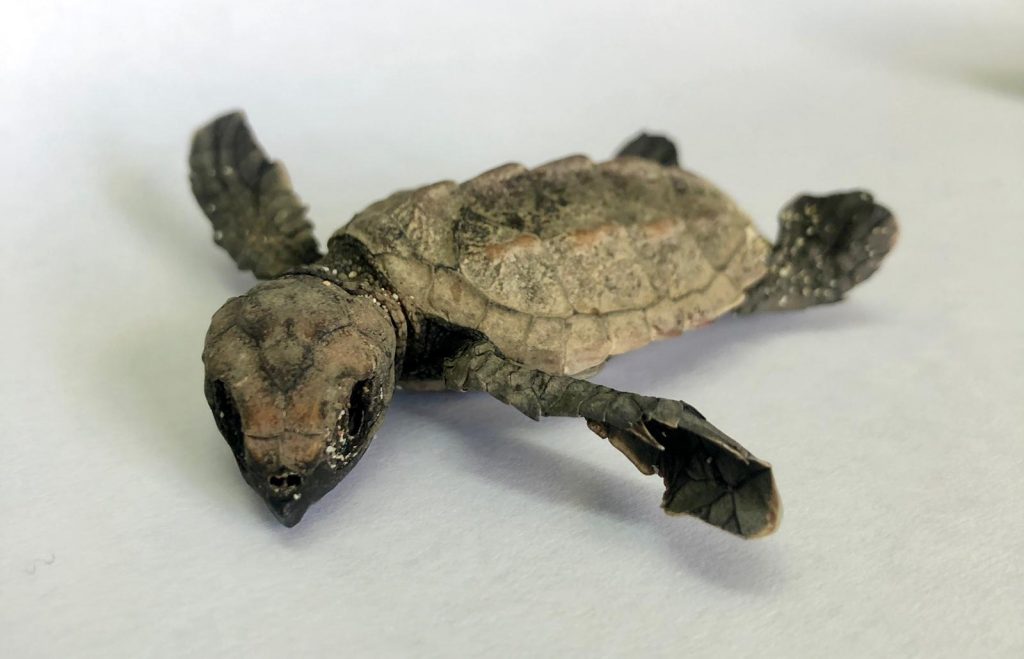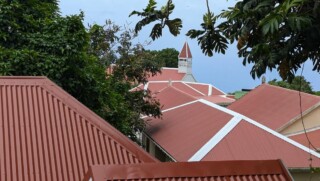Sea Turtle Nesting Season Irregularities Rising on St. Maarten

Philipsburg – Nature Foundation St. Maarten staff encountered two deceased hawksbill (Eretmochelys imbricata) sea turtle hatchlings on Gibbs Bay beach in the beginning of April. Sea turtle eggs their incubation period is 60 days, meaning a female may have laid the eggs sometime in late January. Sea turtles in Sint Maarten typically come ashore to nest in April until the end of November. This finding may be evidence of a late nesting season as more late nests were recorded in December or simply an individual outlier from last year’s season. Hawksbills, one of the three sea turtle species that nest on St. Maarten’s beaches, are critically endangered and protected locally and internationally.
The two hatchlings were found together and appear to have died of natural causes several days before being found, considering their state of decomposition. Only an estimated 1 out of 1,000 sea turtle hatchlings survive to adulthood, it is not unusual for hatchlings to become dehydrated and pass away before reaching the ocean. The Nature Foundation found this pair before they were eaten by predators, fully decomposed, or washed to sea.
Given the irregularity of this discovery, the Nature Foundation encourages all residents and visitors to look out for sea turtle tracks, nests, and hatchlings well outside of the nesting season. In recent years, the months between December and February have shown evidence of a late sea turtle nesting activity. Individuals can protect sea turtles’ livelihood by remaining 5 meters away from any nests and hatchlings, and 15 meters away from actively nesting turtles. The Nature Foundation also discourages individuals from operating heavy vehicles on the beach at any time. Sea turtle nests and eggs are very fragile, and too shallow to prevent damage from vibrations and trampling.
Keeping the beach clean and free of debris also promotes healthy nesting and hatching activities. Adult sea turtles find littered, brightly lit, and noisy beaches unattractive for nesting and avoid laying nests on such shores. The Nature Foundation advises that people fill in holes or moats that they may have dug in the sand. Hatchlings can become trapped in sand pits or entangled in debris on their way to the ocean. Removing recreational items and turning off or shading lights on the beach during the night can help keep sea turtles from turning away from beaches for nesting.
The reason behind the late hatching of these hawksbills on St. Maarten is uncertain. Some coastal areas in the United States and Mexico have experienced changes in their nesting seasons. While there isn’t extensive research into this topic, sea turtles nesting season may change to avoid higher-than-average temperatures due to climate change. In the last 50 years, the Caribbean region has experienced rising land and sea temperatures and warmer extremes. “The temperature of the sand plays a significant role for all sea turtle nests,” explained the Nature Foundation. “Warmer temperatures mean that most of the eggs will end up being female, while cooler temperatures result in male hatchlings. This means as our global temperatures increase, we could see changes in the sea turtle population that would make it even more difficult for them to successfully reproduce.”
However, considering the current scientific uncertainty of climate change’s role in shifting the nesting season period, it is more plausible that it was the individual female’s choice to come ashore and nest late. In December 2020, a hawksbill laid eggs on Gibbs Bay, a month after the end of the season. While unconfirmed, this reported female may be the same one who laid the nest from which the two dead hatchlings were born. Sea turtles often return to the same beach to lay their eggs if the conditions are favorable, and individuals may nest at different times outside the regular season.
Hawksbill sea turtles generally lay between three and five separate clutches per season, averaging between 130 and 160 eggs — more than any other sea turtle species. Yet, they are the most threatened species, with an estimated 8,000 adult nesting females left. One reason for their critically endangered status is their unfortunate connection to the tortoiseshell trade, where their shells are used in jewelry or décor. All species that nest on Sint Maarten are protected by the CITES treaty, SPAW Protocol, and the Nature Conservation Ordinance St. Maarten. It is prohibited to disturb, harm, handle, or kill sea turtles or their nests.
Please contact the Nature Foundation if you find sea turtle tracks, an apparent nest, or hatchlings. Interested individuals can volunteer to patrol beaches on the Dutch side as part of our ongoing nesting data research. The Nature Foundation also encourages St. Maarten residents to spread awareness by checking in weekly to ‘Turtle Thursdays,’ a series of educational programming posted on our social media accounts for all ages.
Also read
- Traveling abroad?

- Curaçao Seeks ‘Level Playing Field’ for Local Airlines

- First Edition of Bonaire by Night on Friday, August 2

- Edsel Winklaar appointed interim director at Selibon N.V.

- Bonaire Human Rights Organization advocates for Bonaire in Azerbaijan













